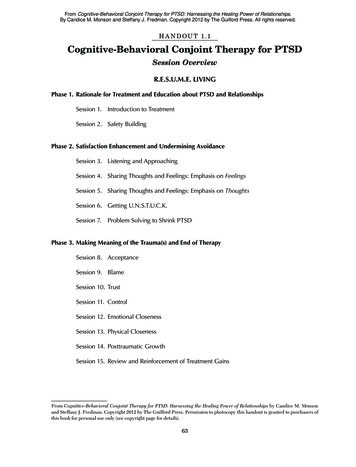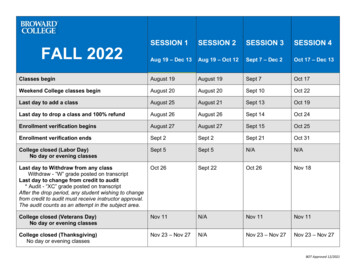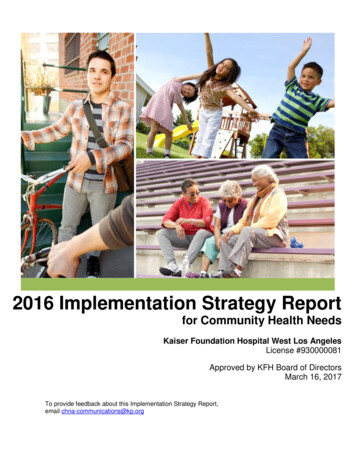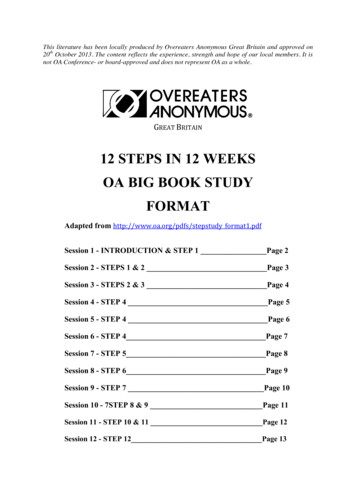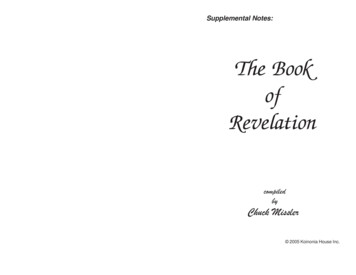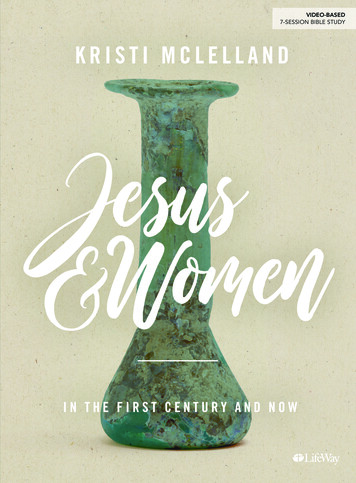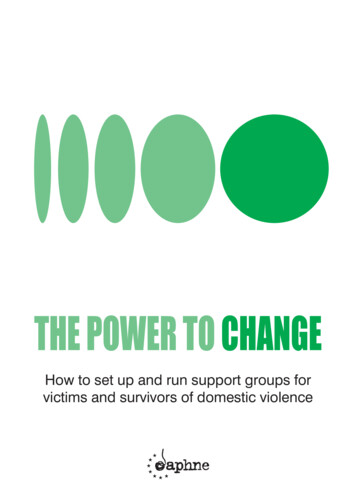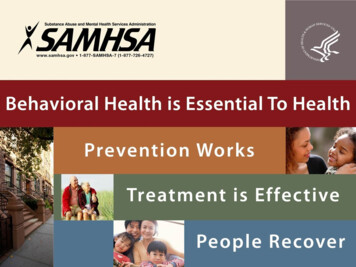
Transcription
1
Focus of the SessionToday’s session will focus on: Requirements Regarding Pregnant Women That All SABGFunded Providers Must MeetSpecial Services for Pregnant Women and Women withDependent Children Maintenance of Effort Requirements2
SABG REQUIREMENTSREGARDING PREGNANTWOMENState Technical Assistance ProjectContract No. HHSS283201200002ITask Order No. HHSS28342002TReference No. 283-12-02023
PurposeWho Are SABG Priority Populations?Early 1990s—Both houses of Congresswere concerned about the spread ofinfectious diseases among: Pregnant women and people whoinject drugsPartners of these individualsThe communities in which they live4
Purpose1993—Substance Abuse Preventionand Treatment Block Grant (SABG)requirements were published and: Identified pregnant women andpeople who inject drugs as prioritypopulationsIndicated that priority populationsshould be granted admissionspriorityIntroduced requirements to limit thewait time for and increase retentionof priority populations5
PurposeSABG-funded states and programs must: Admit priority populations within prescribed time framesOffer priority populations interim services when they cannot beadmitted within those time framesHave systems to effectively track, maintain contact with, andreport on priority populations awaiting admission (i.e., waitinglists)6
RequirementsWhat Are the SABG Capacity Management Requirements?States must require all SABG-funded programs to: Give pregnant women preference in admissionsRefer pregnant women to the State when such womencannot be admittedPublicize the availability of services for pregnant women,including that pregnant women get admissions preference7
RequirementsStates must require programs that serve individuals who injectdrugs to give admissions preference as follows:1. Pregnant women who inject drugs (first preference)2. Pregnant women who abuse substances in other ways (secondpreference)3. Other individuals who inject drugs (third preference)8
Priority PopulationsSABG requires states and programs to take extra efforts to keepthe following populations engaged when appropriate treatmentcapacity is not available: Pregnant women who are seeking treatmentIndividuals who inject drugs and are seeking treatment9
Waiting ListUniform Waiting List is defined as a document that: Identifies individuals who are seeking treatment whenappropriate treatment slots are not availableIs a written log/roster that a treatment program maintains whenservice capacity has been reachedIdentifies individuals who are actively seeking treatment andwho meet eligibility criteria10
Waiting ListFor pregnant women who cannot be admitted, states must: Maintain a continuously updated system for identifyingtreatment capacity for pregnant women andHave a mechanism for matching these women to treatmentwith sufficient capacity11
Interim ServicesWhat Are Interim Services?SABG-funded programs must offer interimservices within 48 hours when the followingpriority populations cannot be admitted orreferred to other programs with sufficientcapacity: Pregnant womenIndividuals who inject drugs12
SPECIAL SERVICES FOR PREGNANT WOMENAND WOMEN WITH DEPENDENT CHILDREN13
BackgroundWhat Was the Congressional Impetus Behind the Special Servicesfor Pregnant Women and Women With Dependent Children(Women’s) Maintenance of Effort? Institute of Medicine study that pointedto cost offsets of comprehensive servicesfor women with dependent children.Focus on expanding residential andoutpatient options for this population.Support for residential programs forwomen with dependent childrenprioritized as a modality that offerscomprehensive services.14
Calculating the Women’s MOEWhat is the Women’s Maintenance of Effort Funds?Each (state) fiscal year, states must expend an amount that is atleast equal to base-year expenditures (established in the 1990s).15
Covered PopulationsWhich Populations Are Covered by the SABG Funds for SpecialServices for Pregnant Women and Women With DependentChildren? Pregnant womenWomen with dependent children, including women who aretrying to regain custody of their children16
Required ServicesWhat Services Are Required of Programs That Receive SABGFunds for Special Services for Pregnant Women and Women WithDependent Children?States must ensure that programs that receive these funds provideor arrange for all of the following: Primary medical care, including prenatal care Primary pediatric care, including immunizations, for thewomen’s children Gender-specific substance use disorder treatment and othertherapeutic interventions for women17
Required Services Therapeutic interventions for children in custody of women intreatmentChild care while women are receiving servicesSufficient case management and transportation to ensure thatthe women and their children can access the other servicesStates must also ensure that programs that receive these fundstreat the family as a unit.18
Primary Medical Care andPediatric CarePrimary medical and pediatric care for women and their childreninclude services such as: Physical examinations.Treatment of medical conditions.Complete prenatal care.Immunizations.Dental care.Behavioral health care.19
Primary Medical Care andPediatric CareSources of primary and pediatric care, particularly for low-incomeclients, include: Medicaid.Health Resources Services Administration-sponsored healthcenters.Federally qualified health centers.20
Gender-Specific Treatment andOther Therapeutic InterventionsGender-specific substance use disorder treatment and othertherapeutic interventions for women: Maintain a gender-responsive treatment environment.Use a strengths-based model.Incorporate an integrated, multidisciplinary approach.Address women’s unique health concerns.Incorporate a trauma-informed orientation.21
Gender-Specific Treatment andOther Therapeutic Interventions Promote culturally competent services that are specific towomen.Are sensitive to how ascribed roles and gender expectationsacross cultures shape societal attitudes toward women withsubstance use disorders.Recognize the role and significance of relationships in women’slives, including various caretaker roles that women assumethroughout life.Acknowledge the importance and role of socioeconomicconditions of women compared to men.22
Child CareChild care while women are receiving services is importantbecause: More than 1.4 million children live with mothers who are singleparents who have substance use disorders.The lack of child care is a major barrier to treatment for many ofthese women.Reliable child care is associated with longer treatment lengths(i.e., retention), improved outcomes, and sustained recovery.23
Child CarePrograms that receive these funds may: Provide child care directly or arrange for it through anotherservice.Use SABG funds or other funds to pay for the services.24
Therapeutic Interventionsfor ChildrenTherapeutic interventions for children might address issues such as: Developmental needs.Sexual and physical abuse.Neglect.25
Case ManagementSufficient case management: Provides the client a single point of contact with health andsocial services.Is client-driven and driven by client need.Assesses clients’ strengths and limitations and social, financial,and institutional resources.Involves an individualized service plan.Advocates on behalf of the plan for needed resources andservices.26
Case ManagementCase management also: Is community based.Mobilizes formal and informal resources and services.Is pragmatic, anticipatory, flexible, and culturally sensitive.27
Treating the Family As a UnitTreating the family as a unit has multiple benefits: It addresses a reality—70% of women entering treatment havechildren, so it reduces barriers to treatment.Treating families as a unit improves outcomes for each familymember.Research continues to suggest that including children intreatment, particularly residential treatment, is essential tomothers’ recovery.28
Treating the Family As a UnitA SAMHSA study found that each dollar spent on family-centeredtreatment for parental substance use disorders saved 3.71 inareas such as: Welfare.Crime.Foster care.Care for babies with lowbirth weights.29
Reminder About Required ServicesPrograms that receive these funds must provide directly or arrangefor all of the required services.30
Additional Recommended ServicesThe SABG also encourages states to require that programsreceiving these funds to provide or arrange: Case management to assist with establishing eligibility forfederal, state, or local public assistance programsEmployment and training programsEducation and special education programsDrug-free housing for women and their childrenTherapeutic day care, Head Start, and other early childhoodprograms31
Payment of Last ResortThese funds must be used: As the “payment of last resort,” andOnly for clients who have no other financial means for obtainingthese services.32
Fund SourcesPrograms often look beyond their own funds to put together thecomprehensive package of services.Many of the women and their children are eligible for otherfederal, state, and local support that offer: Primary medical and pediatric care.Therapeutic interventions for children.Transportation services.33
Fund SourcesMany of these programs also maximize resources for services andoperations through a combination of: Effective resource development initiatives.Pro bono/volunteer services.In-kind contributions.34
Resources on ComprehensiveServices For WomenSAMHSA’s “TreatmentImprovement Protocol (TIP) 51,Substance Abuse Treatment:Addressing the Specific Needs ofWomen,” is a good resourcemanual on comprehensive servicesfor women.35
Resources on ComprehensiveServices For WomenTIP 51: Presents a biopsychosocialcultural framework based on clinicalpractice and research.Examines women’s treatment needs, approaches, andexperience.Highlights promising and best practices.Explores evidence-based research and clinical issues that affecttreatment for women.36
Upcoming WebinarsThursdays 3pm (Eastern) on FocusDecember 7, 2017Capacity management requirementsregarding access to care for prioritypopulationsDecember 14, 2017Requirements regarding SABG fiscaltracking and management37
THANK YOU38
It addresses a reality —70% of women entering treatment have children, so it reduces barriers to treatment. Treating families as a unit improves outcomes for each family member. Research continues to suggest that including children in treatment, particularly residential treatment, is essential to mothers' recovery.




